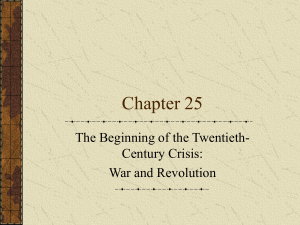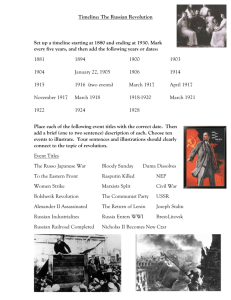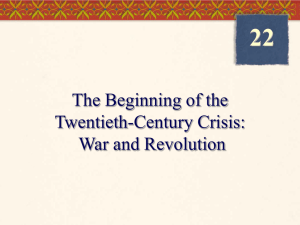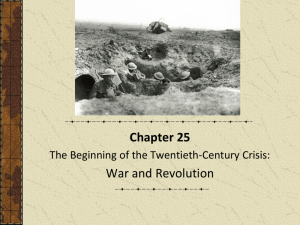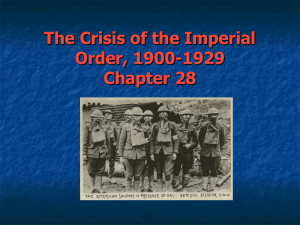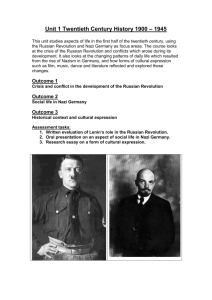25-_WWI_and_The_Russian_Revolution
advertisement
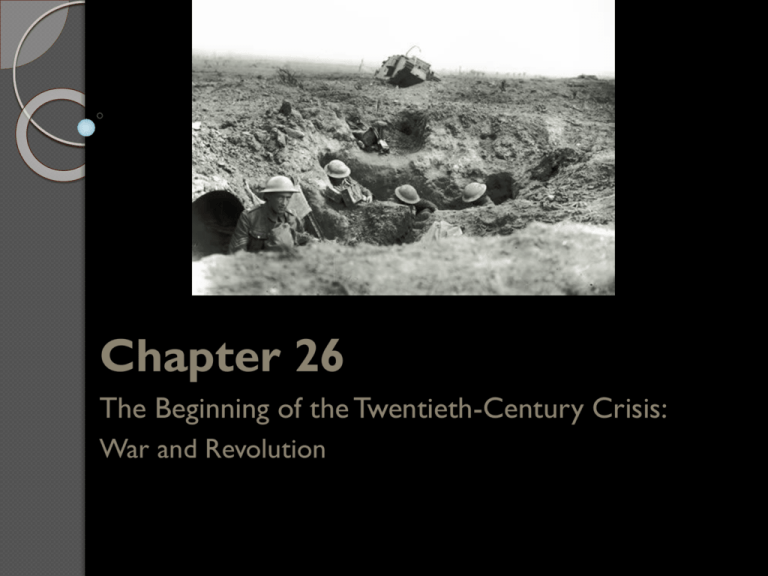
Chapter 26 The Beginning of the Twentieth-Century Crisis: War and Revolution The Road to World War I Nationalism and Internal Dissent ◦ Nationalism Liberals claimed that creation of national states would bring peace Led to competition instead of cooperation Brinkmanship ◦ Internal dissent Ethnic tensions Growing power of Socialist labor movements Use of war to divert revolutionary tide at home Militarism ◦ Conscription and growing armaments ◦ Influence of military leaders ◦ Military plans International Rivalry and the Coming of War New Alliances ◦ Triple Alliance, 1882 – Germany, Austria, Italy ◦ Reinsurance Treaty between Russia and Germany, 1887 ◦ Dismissal of Bismarck, 1890 and Wilhelm’s lapse ◦ Military alliance of France and Russia, 1894 New Directions and New Crises ◦ Entente Cordiale, 1904 ◦ Emperor William II’s “place in the sun” and the Moroccan Crisis ◦ Triple Entente, 1907 – Britain, France, Russia ◦ Triple Alliance, 1907 – Germany, Austria-Hungary, Italy Crisis in the Balkans, 1908-1913 Austria annexes Bosnia and Herzegovina, 1908 as allowed by Berlin Conference and San Stefano revision Serbian protest, Russian support of Serbia Balkan Wars, 1912-1913 ◦ Serbia’s Ambitions ◦ Russian support of Serbia ◦ Austria-Hungary’s determination to limit Serb ambition The Balkans, 1878 Map 25.1: Europe in 1914 The Road to World War I The Outbreak of War: The Summer of 1914 ◦ The effects of the Balkan Wars prior to 1914 ◦ Assassination of Archduke Francis Ferdinand and wife Sophia, June 28, 1914 by 18-yr. old Gavrilo Princip of Black Hand Society ◦ Germany’s Chancellor Theobald von Bethmann-Hollweg gives “full support” to Austria (“Blank Cheque”) ◦ Russian mobilization ◦ Schlieffen Plan requires march through neutral Belgium to get to France I’m gonna git you sucka! The Schlieffen Plan aka “oops, we pissed off the Brits!” The War 1914-195: Illusions & Stalemate European attitudes toward the beginning of war and the “war craze” Failure of the Schlieffen Plan First Battle of the Marne, September 6-10, 1914 Russian Failures ◦ Battle of Tannenberg, August 30, 1914 ◦ Battle of Masurian Lakes, September 15, 1914 Austrian Failures ◦ Galicia and Serbia – trouble with the Russians ◦ Germans come to Austria’s aid Battle Scene in Northern France The War 1916-1917: The Great Slaughter Trench warfare ◦ “No-man’s land” ◦ “Softening up” the enemy ◦ Battle of Verdun, 70,000 lost (German offensive) ◦ Battle of the Somme, 1916 (Allied offensive) Heaviest one-day loss in World War I 300,000 lost To draw German soldiers from Verdun Trench Warfare in France Trench Warfare Trench Warfare in Color From The Somme (2005) Trench Life = Hell… “Live and let live” Trench Magazines – B.E.F. Times Map 25. 2: The Western Front, 1914-1918 Map 25.3: The Eastern Front, 19141918 The Widening of the War Both sides attempt to tip the scales in their favor by gaining new allies August 1914: Ottoman Empire enters the war for Central Powers ◦ Battle of Gallipoli, April 1915 ◦ ANZAC Troops and “…Waltzing Matilda” May 1915: Italy enters the war against Austria-Hungary September 1915: Bulgaria enters the war on the side of the Central Powers Middle East ◦ Lawrence of Arabia (1888-1935) Arab princes vs. Ottoman forces The Widening of the War April 1917: Entry of the United States ◦ The United States tried to remain neutral ◦ Naval Conflict between Germany and Britain ◦ Sinking of the Lusitania, May 7, 1915 ◦ Return to unrestricted submarine warfare, January 1917 ◦ United States enters the war, April 6, 1917 Bolshevik Revolution, 1917 Italian defeat Failure of Western front offensives Both sides were exhausted! A New Kind of Warfare Air Power ◦ 1915: first use of airplanes on the battle-front ◦ German use of zeppelins Tanks ◦ 1916: first use of tanks on the battlefield ◦ Early tanks ineffective ◦ 1918: British Mark V first effective tank The Home Front: The Impact of Total War Government Centralization Conscription Effects on Economies Public Order and Public Opinion ◦ ◦ ◦ ◦ ◦ Dealing with unrest Strikes Irish Revolt 4/1916 Defense of the Realm Act (DORA) Propaganda Social Impact of Total War ◦ Labor benefits prestige for trade unions ◦ New roles for women Male concern over wages Women began to demand equal pay Gains for women The Last Year of the War Withdrawal of Russia gives Germany hope Ludendorff launches last German offensive, March 21-July 18, 1918 Allied counterattack, Second Battle of the Marne, July 18, 1918 General Ludendorff informs German leaders that the war is lost William II abdicates, November 9, 1918 German soldiers, workers revolt Republic established under Ebert Armistice, November 11, 1918 The Casualties of the War ◦ 8 to 9 million soldiers killed, 22 million wounded Revolutionary Upheavals in Germany and Austria-Hungary Revolution in Germany ◦ Division of German Socialists ◦ Formation of two governments ◦ Failure of radicals to achieve control Revolution in Austria ◦ Ethnic upheaval ◦ Formation of independent republics The Peace Settlement Palace of Versailles, January 1919, 27 Allied nations: “Eternal Peace” Lenin and the secret treaties Woodrow Wilson, Fourteen Points Pragmatism of other states Lloyd George determined to make Germany pay Georges Clemenceau of France concerned with his nation’s security Concern over the spread of Bolshevism January 25, 1919, the principle of the League of Nations adopted The Treaty of Versailles Five separate treaties (Germany, Austria, Hungary, Bulgaria, and the Ottoman Empire) The most important was the Treaty of Versailles, June 18, 1919 ◦ ◦ ◦ ◦ ◦ Article 231, War Guilt Clause 100,000 man army Loss of Alsace and Lorraine Sections of Prussia to the new Polish state German charges of a “dictated peace” The Other Peace Treaties German and Russian Empires lost territory in eastern Europe New nation-states: Finland, Latvia, Estonia, Lithuania, Poland, Czechoslovakia, Austria, and Hungary Romania acquired additional lands from Russia, Hungary, and Bulgaria Yugoslavia – multinational powder keg Compromises will lead to future problems Minorities in every eastern European states Ottoman Empire dismembered ◦ Promises of independence of Arab states in the Middle East ◦ Mandates France – Lebanon and Syria Britain – Iraq and Palestine United States Senate rejects the Versailles Peace Treaty Map 25.5: Europe in 1919 The Middle East in 1919 Timeline The Russian Revolution By 1900 the fourth largest producer of steel ◦ Count Sergei Witte – Minister of FInance ◦ Development of working class ◦ Development of socialist parties Marxist Social Democratic Party, Minsk, 1898 Russo-Japanese War, 1904-1905 General strike, October 1905 ◦ Bloody Sunday at the Winter Palace ◦ Nicholas II granted civil liberties and a legislative body, Duma ◦ Voting and Land Reforms of Prime Minister Peter Stolypin ◦ Stolypin’s assassination by left…or right? ◦ Curtailment of power of the Duma, 1907 The Russian Revolution War and Discontent ◦ Nicholas II was an autocratic ruler ◦ Russia not prepared for war ◦ Government suspicion of war enthusiasm ◦ Influence of Rasputin The Russian Revolution The March Revolution ◦ Problems in St. Petersburg ◦ March of the women, March 8, 1917 ◦ Calls for a general strike ◦ Soldiers join the marchers ◦ Provisional Government takes control 3/12/1917 Tsar abdicates 3/15/1917 Alexander Kerensky (1881-1970)- Mensheviks Tried to carry on the war Soviets sprang up ◦ Bolsheviks under the leadership of Vladimir Ulianov, 1870-1924 Sent back to Russia in a sealed train by the Germans April Theses “Peace, land and bread” “All power to Soviets” Map: The Russian Revolution Russian Revolution (cont) The Bolshevik Revolution ◦ ◦ ◦ ◦ ◦ Bolsheviks control Petrograd and Moscow soviets Army Order #1 Kerensky vs. Kornilov…Bolsheviks empowered! Collapse of Provisional Government, November 6-7, 1917 Treaty of Brest-Litovsk, March 3, 1918 – Russia exits WWI Civil War ◦ ◦ ◦ ◦ ◦ ◦ ◦ Bolshevik (Red) army and Anti-Bolshevik (White) army Murder of the Tsar and his family (July 16, 1918) Disunity among the white army Role of Trotsky as War Commissar Communists and “War communism” Invasion of allied troops 1921: Communist victory Discussion Questions Why were so many Europeans eager for war in 1914? Did Europe’s governments share their enthusiasm? What was “total war”? How did European governments meet the challenge of total mobilization? Why were so many people in the United States reluctant to get involved in World War I? Why did Woodrow Wilson see U.S. involvement as a necessity? Describe the goals of the major participants at the peace talks. How were these goals incorporated into the Treaty of Versailles? Web Links World War I: Trenches on the Web The First World War: A Multimedia History World War I: Document Archive The Russian Revolution The Empire That Was Russia

